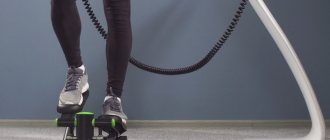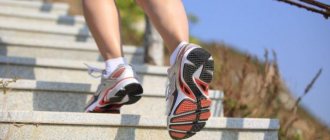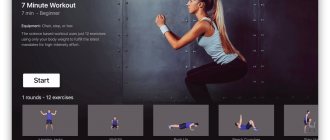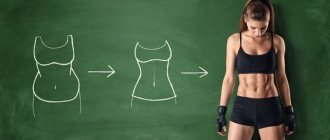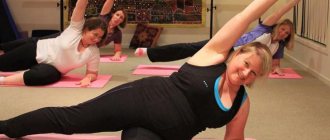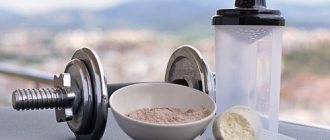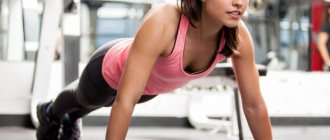I welcome everyone who is involved in or is just planning to engage in sports for the sake of health, beauty or achievements. Today we will talk about an incredibly useful, but undeservedly forgotten and underestimated technique, which was created to create an ideal and aesthetically beautiful body.
The very word shaping may cause many athletes to smirk slightly, but I can assure you: properly conducted training, and even under the guidance of a competent trainer, will make you count the minutes until the end of the lesson. In this article we will look at what this training method is, what its features and secrets are, and we will also find out its strengths and weaknesses.
What is shaping
Shaping refers to a special type of gymnastics, which, like different types of aerobics, is directly related to rhythm. The difference between shaping is that one lesson combines both aerobic exercise, intended for fat burning, and anaerobic exercise, the main task of which is to build and tone muscles. It is more correct to contrast shaping not with classical aerobics, but with complex types of training, such as body pump or step aerobics. It can also be compared to fitness, given similar training goals, loads and effects.
I want to reassure women who are still scared by the word “muscle”. It is impossible to create a “masculine” figure through shaping classes or simply go overboard with muscle volume. The methodology itself includes achieving ideal parameters of the female body as a primary goal. Those parameters of shaping models that distinguish 9 types of female body constitution, identified through research, are considered partially outdated today.
Over the almost 30 years of shaping, the standards of female beauty have changed significantly, so the principles of training and load distribution may differ. For example, during training, the number of strength exercises on the buttocks and quadriceps has increased, since volumes are now in trend. But the goals, objectives and methods of shaping did not suffer any changes.
It would be a big mistake to judge shaping as a women's sport. Men can benefit greatly from this type of training, especially when combined with strength training. It has been proven that shaping training in weightlifting, powerlifting and bodybuilding helps eliminate joint pain, improve mobility and flexibility. I'm not even talking about the increase in endurance and muscle functionality that this type of gymnastics can provide.
Therefore, the attitude of shaping towards “female” types of sports activity is nothing more than a mass delusion and unfounded stereotypes.
Brief history of origin
Shaping can safely be considered a 100% Russian form of gymnastics. It was created by physiologist Ilya Prokhortsev, who is also the current president of the International Shaping Federation. The technique itself was born in the late 80s of the last century, although gymnastics received a patent only in the early 90s. Since 1994, Shaping has become a global brand and has been actively popularized as an effective method of figure correction.
Moreover, shaping not only became a brand, but laid the foundation for a kind of sports ideology, in which fitness holds the palm today. Shaping also has its own anthem, which was created thanks to the collaboration of composer Alexey Golubev and performer Vitaly Psarev.
Advantages
The benefits of shaping for women are undeniable. Exercise not only makes your figure beautiful and fit, but also affects the psychological state of the body.
What are the positive aspects of training:
- Shaping classes lift your spirits for the whole day.
- Muscle training charges the body with energy and vigor.
- Performing exercises leads to the achievement of internal harmony, allows you to mentally relax and get psychological relief.
- Getting the desired result in figure correction.
- Shaping helps strengthen and maintain the health of the muscular system.
- Helps get rid of cellulite.
Improving your body and improving the psychological state of the body is how shaping is useful for women. It is important to remember that positive results will not come immediately; the effect of exercise comes gradually, but it is quite stable.
The essence and meaning of training
The essence of training is to perform exercises in a strictly specified sequence. Chaotic training cannot be called shaping (even if the same movements and loads are used), it will not provide significant benefits.
Each shaping training includes two components:
- Catabolic. High-repetition aerobics designed to burn more calories and burn fat.
- Anabolic. Perform anaerobic movements to grow muscles.
Depending on training goals, group, and other factors, the ratio of anabolic to catabolic loads within individual sessions may vary. For example, for enhanced fat burning, the share of aerobic exercise in shaping will increase. And vice versa - when the problem of excess fat deposits gives way to the need to build aesthetically beautiful muscles, priority will be given to the anabolic phase (called body shaping).
Briefly about equipment and clothing
In fact, shaping classes are not at all demanding in this regard. All you need is a mat. But if you want to diversify your workouts by working out at home, you can get:
- dumbbells;
- fitball;
- step platform.
Sportswear should be comfortable, not restrict movement and not interfere with exercise. It is advisable to choose a moisture-wicking material. As for footwear, it is better to give preference to sneakers with heel cushioning.
What muscles work
One of the most important advantages of shaping is that the workout involves almost all the muscles of the body. Most of the exercises are basic in nature and involve a huge number of muscle fibers. This allows you not only to evenly distribute the load during exercise, but also to evoke the hormonal response necessary for muscle growth. Shaping also includes a large number of complex exercises that combine at least two movements. For example, thrusters, swings to the sides with arms moving forward, and others.
In modern shaping, exercises with TRX loops, fitballs, training ropes, harnesses and other equipment often appear. This allows you to provide a versatile load on the muscles and increase the effectiveness of training.
Kinds
There are 5 main types of shaping. I don't recommend thinking of them as specific lesson plans. These are rather shaping directions that determine the nature of the loads, exercises and other conditions. I also want to make it clear that not all types of shaping are specific to sports. The same shaping has nothing to do with gymnastics - it is a cosmetological set of exercises for the face.
Classical
Basic shaping. The workouts include anabolic and catabolic parts. Such classes are suitable for developing physical abilities and body shaping.
Therapeutic
Training aimed at recovery and rehabilitation after injuries, some chronic diseases and other health problems. This shaping is characterized by soft and gentle stress on the muscles and increased rest between exercises. Therapeutic training is also prescribed for obesity for people who find it difficult to do classical exercises.
About
The most complex and difficult preparation. The highest level of development in shaping, which requires serious physical training and experience. Classes are long, loads alternate from moderate to submaximal, exercises are often combined in series.
Uni
Shaping programs for children and adolescents. In addition to the modified load, they include an increased number of movements to improve posture, uniform muscle development, and increase endurance.
Shaping for those over 50
Specially designed workouts for older people. The loads are selected taking into account the formed groups and are more of a preventive nature.
There are also various subcategories, the number of which amounts to dozens. For example, class 5 – training with the addition of choreographic exercises with different types of load. Often other types of physical activity are added to shaping classes. For example, in fitness centers that have a swimming pool, hydroshaping is almost always added. It can be used as an additional or main part of the workout.
Home activities: what to consider?
Shaping at home will be effective if, when performing exercises, you feel a load in the muscle groups it is aimed at. If this does not happen, then the exercise is not being performed correctly and should be postponed to avoid injury.
One muscle group is trained for at least 4 minutes - 2 at an intense pace, 2 at a slow pace or stretching. The total duration of the workout is about 60 minutes (again, taking into account personal endurance and physical fitness).
At home, they often perform a set of exercises aimed at correcting:
- upper body (shoulder girdle, arms, chest);
- waist and abs;
- thighs and buttocks;
- lower legs (calf muscles and feet).
A separate group consists of exercises for joint flexibility and stretching. One workout involves working on a specific part of the body, such as the glutes, inner and outer thighs.
What is the difference between shaping and fitness?
Although fitness and shaping largely use the same exercises, their application and rotation in training programs differ significantly. The main difference is considered to be the intensity of the training and the use of muscles; in shaping they are much higher. In addition, training is clearly divided into catabolic and anabolic phases. This allows you to better combine different exercises and structure your training program.
An insignificant difference lies in the fact that in shaping most of the exercises are performed in a lying or sitting position (when the body is parallel to the floor), in general this creates less stress on the spinal column and is better suited for rehabilitation after injuries.
To summarize, shaping is more like “aerobic fitness”, which has been infused with more elements from classical aerobics. Unlike regular fitness, shaping classes are conducted in a group format. They are more energetic and driven, and interaction with the coach continues throughout the entire training session.
It is also believed that shaping is more suitable for weight loss due to increased energy consumption and large volumes of workload, but I attribute this more to marketing ploys. As with shaping, in regular fitness you can also increase the intensity of your workouts and do series of exercises, especially if you perform cyclic circuit programs.
Fitness aerobics or shaping what to choose
If you only want to build muscle and do not have problems with excess fat, then I would recommend choosing fitness: it will allow you to achieve your goals faster. In terms of building muscle mass, it is superior to shaping, and besides, the presence of a catabolic phase in fitness is not necessary. But if you want to change the proportions of your body by growing muscles and burning fat, as well as get rid of cellulite, then shaping exercises will be preferable.
Training and exercises are aimed at several tasks at once; such exercises will save time and achieve results faster. Otherwise, I don’t see any significant differences, except for the intensity of muscle loads and training format, so choose what suits your preferences.
What's the benefit?
Shaping classes allow you to show the necessary vital activity that is lacking in everyday life. If you practice in a positive group, you can get a powerful boost of energy, meet interesting people and simply disconnect from endless daily problems. You will set a joint goal of working on yourself and will achieve success together.
The diet for the duration of classes is selected individually, but there are features that everyone needs to take into account. This will help you quickly and effectively remove excess weight, fat and eliminate problems in the gastrointestinal tract. Training also has a beneficial effect on all organs and systems of the body and allows you to get rid of problems with the spine, stoop and fatigue. Your walk will become bright and elegant, and you will look young and beautiful.
Indications and contraindications
The uniqueness of shaping lies in the scientific basis of the technique, which allows us to highlight a list of specific indications and contraindications. Classes are recommended in the following cases:
- Correction of the figure and changes in the balance of fat and muscle mass.
- Increased endurance.
- Improved coordination and muscle control.
- Losing weight while maintaining muscle volume.
- Elimination and prevention of problems with the musculoskeletal system.
- Strengthening muscles.
- Achieving ideal body proportions (relevant not only for women, but also for men).
- Strengthening the immune system.
- Treatment of insomnia, depression and other disorders.
- General health promotion.
Contraindications to shaping should be divided into two categories: temporary and absolute. Temporary ones include exacerbations of chronic diseases, colds, fever and injuries. To absolute (when classes are prohibited in any cases):
- Oncological diseases.
- Hypertension or other cardiovascular diseases.
- The period of breastfeeding, menstruation, as well as the first trimester of pregnancy.
People with flat feet and varicose veins should sign up for shaping only after consulting a doctor. In this case, you may have to exclude some exercises and types of loads from the program.
Anthropometric measurements
Body types
During a preliminary anthropometric examination, women who want to engage in shaping for the purpose of losing weight have their wrist volume, chest circumference, height and weight measured. The Pinier index is calculated (height in centimeters minus the sum of chest volume in centimeters and weight in kilograms). Based on the data obtained, the main constitutional body type is determined, which is 95% determined by genetic factors.
- Thin-boned (asthenic, hyposthenic)
Wrist volume – up to 14.5 cm inclusive. The Pinier index is more than 30. These are thin, thin-boned people with disproportionately long limbs, poorly developed muscles, narrow shoulders, small breasts, long necks and pale skin, and lack of adipose tissue. Women have a boyish figure without curves.
- Normoskeletal (normosthenic)
Wrist volume - from 14.6 to 16.5 cm inclusive. The Pinier index is from 10 to 30. Such people are distinguished by well-developed muscles, a strong bone skeleton, a convex chest, broad shoulders, and proportional limbs. The amount of adipose tissue is normal.
- Broad-boned (hypersthenic)
Wrist volume - from 16.5 cm or more. Pinier index is less than 10. These are short, plump people with a high diaphragm and a short neck. The amount of fatty tissue in the body and the level of cholesterol in the blood are above average. They are often obese.
All this data is entered into a computer program, but the measurements do not end there.
Shaping models
Next, the degree of development and proportionality of the bones of the upper and lower extremities is tested. To do this, additionally measure the volume of the waist, pelvis, hips, arms, and the length of the limbs. After entering the data into the computer program database, it is automatically correlated with the body type determined at the previous stage. And the final result is given - what kind of figure shaping model the woman has. There are 9 of them in total:
- narrow-narrow;
- narrow-medium;
- narrow-wide;
- medium-narrow;
- medium-medium;
- medium-wide;
- wide narrow;
- wide-medium;
- wide-wide.
These shaping models allow you to see where problems exist. The middle top and middle bottom are considered the most ideal option, for which simply healthy exercises are selected to maintain normal weight and improve overall well-being. Where it is “narrow”, muscle mass is built up to create a sculpted figure. Where it is “broad”, all efforts are directed towards fat burning and weight loss.
General physical indicators
Afterwards this is measured:
- pressure;
- heart rate;
- vital capacity of the lungs;
- performance (determined by the speed of recovery after performing 20 squats in 30 seconds);
- endurance (step test);
- reaction speed (using a reactiomer);
- flexibility (there is a special device);
- force (strength meter).
And again the data is entered into a computer program. After that, it finally gives the recommended ones:
- set of exercises;
- class time;
- duration;
- intensity;
- frequency
Along the way, the program determines how many calories per day you need to consume and how much to spend in order to achieve an ideal figure (for losing weight or building muscles). General nutritional recommendations are given.
Benefits and harms
Let's look at the main pros and cons of shaping for health. I consider the main advantages:
- Exciting, energetic and invigorating workouts, devoid of routine.
- Group training format (almost always training with friends or like-minded people is more interesting and effective than doing it alone).
- Formed training goals and the most effective ways to achieve them (incorporated into the methodology itself).
- High energy consumption, as a result, accelerated fat burning.
- A great way to simultaneously develop aesthetic muscles and remove excess fat.
- Beneficial effect on joints and ligaments.
- Development of coordination and flexibility.
Even if classical shaping is foreign to you, I recommend including some of its elements and exercises in your workouts or alternating them with strength training. This is equally beneficial for both women and men.
The disadvantages I consider:
- Presence of a catabolic phase. It will slow down muscle building in cases where fat loss is not required.
- The need to carefully form groups, selecting people with equal levels of physical fitness (the problem with all group sports).
There are no other disadvantages or potential harm to health in shaping.
Contraindications or who should not
In order not to harm your health, you need to know about contraindications to shaping. Discipline cannot be practiced when:
- critical days;
- oncology;
- diseases of bones and blood;
- thrombosis;
- thrombophlebitis;
- tuberculosis;
- epilepsy;
- asthma;
- glaucoma;
- pathologies of the liver and kidneys;
- hypertension.
That's all. I hope you found the information in this article useful. You have learned everything you wanted about such a discipline as shaping. Perhaps you will decide to master it, because it is an excellent workout that gives results confirmed by more than one woman.
Good luck to all! See you!
Training in the gym or at home: what to choose
Despite the fact that shaping can be done at home, I highly recommend training with an instructor. Especially if you do not thoroughly understand the mechanics of exercises, the combination of movements, building the correct sequence and other conditions.
Also, group classes with a trainer will allow you to quickly master shaping programs and speed up your progression. I would consider options for home training in shaping only in cases where you yourself have studied the theory and understand the methodology, have mastered all the exercises, do not like group training, or want to save money.
Nutrition is an important aspect of losing weight
It is important to strictly adhere to the diet prescribed by your personal instructor. It is selected based on your condition. It must be strictly followed to achieve maximum effect. It is recommended to limit or eliminate fats and carbohydrates as much as possible. Remember that exercise is not the only factor in losing weight. If you do not adhere to a balanced diet, then there will be no benefit from exercising or it will be minimal. With the right approach, losing extra pounds will happen faster and easier.
How to practice at home correctly
If you have chosen the “home route”, then you need to properly organize your training. This is not only the study of the basic theory, basic principles, exercises and shaping programs, but also the preparation of the place for classes. This is the only way to make training at home as effective as in the gym.
Necessary inventory and equipment
One of the important advantages of shaping is the minimum set of equipment for classes. To train, all you need is to purchase a pair of collapsible dumbbells and a mat. If you want to significantly diversify your workouts and use a full arsenal of exercises, I recommend adding to the list any analogue of TRX loops or harnesses, a step platform or bench, as well as a fitball.
There are no restrictions in terms of clothing. The main thing is that it does not interfere with movements and absorbs sweat. Regular shoes are fine, but sneakers must have a heel and at least minimal heel cushioning.
Nutrition and supplements during exercise
Taking into account the load and high calorie expenditure in shaping, a radical change in diet is not required. But if you want to quickly get rid of belly fat, get in shape for summer, or change your figure in a short time, in addition to training, it is better to change your diet. Diets based on paleo and keto principles are good for shaping.
I do not encourage you to scrupulously follow all the instructions of the same paleo diet or other diet. Moreover, I insist that the diet include cereals and low-fat dairy products. It is better to adopt the basic principles and fundamentals from these nutritional plans rather than blindly copy them.
Regarding additives:
- Protein. Source of amino acids.
- BCAAs. Only before exercise to avoid burning out the muscles during the catabolic phase.
- Green tea extract or caffeine capsules for energy and alertness during training (if necessary).
- Omega-3 and vitamin-mineral complexes. To support the body and metabolic processes.
Where to start first
You need to start training by purchasing equipment, without which it will be difficult to perform the exercises, and understanding the basic principles of shaping. In the first stages, you can use ready-made training programs where all the exercises are prescribed, although later you will still have to make some adjustments to them.
If it is difficult to conduct a full session (usually lasts 50-60 minutes), then you can reduce the intensity of the exercises for 1-2 months and reduce the training time to 30-40 minutes.
Number and duration of training
Training time depends solely on the level of training of the athletes and the choice of exercises, as well as on the goals of a particular complex. For example, cycles with a predominance of anabolic loads will be shorter in time, and catabolic exercises will be longer. If we take into account the optimal ratio of each type of load within the framework of classical training, then the average lesson is from 50 to 60 minutes, taking into account warm-up and cool-down.
The number of workouts per week is 2. The classes are quite grueling and include a lot of exercises, so only trained athletes with experience can withstand 3 shaping workouts per week.
What time to train
The beauty of shaping is that you can do it at any time of the day when the gyms are open. And if you train at home, then without any restrictions at all, even in the middle of the night. For maximum effectiveness of all exercises, I recommend training either in the morning (3 hours after waking up) or in the evening (4-5 hours before bedtime).
Nutrition during shaping exercises
Nutrition in shaping is not an exclusive and innovative system; on the contrary, it is necessary to adhere to simple and understandable principles of proper nutrition, namely:
- Refusal of flour and confectionery products, fruits and drinks with a high glycemic index. Products with glycemic index here →
- Stick to 3-4 meals a day.
- Vegetables should predominate in the diet, with complex carbohydrates in second place, namely various cereals high in fiber.
- Lean meat, steamed, oven-baked or boiled, should be consumed in larger quantities in the afternoon than carbohydrates, which predominate in the first half of the day. Protein foods also include dairy products, eggs, fish and seafood.
- Refined saturated fats in the diet are reduced to a minimum - butter, sunflower oil, unrefined oils, seeds and nuts remain.
- Fruits are also present in the diet, but in moderate quantities, which should not be consumed at night.
- You can drink any soft drinks with a minimum amount of sweeteners.
Correct technique and basic shaping exercises
Particular attention in shaping is paid to execution technique. Of course, it is important in all sports, but with long-term training, especially with steadily increasing fatigue, violations of technique become more frequent. You must always remember this and make sure that every movement is performed correctly.
Among the main exercises in shaping are:
- Deep squats.
- Maintain a stance with wide feet.
- Stepping onto a platform or bench.
- Gluteal bridge.
- Taking the leg back (the body is parallel to the floor).
- Swing your legs to the sides.
- Low rolls (or “Cossack dance”).
- Leg abduction (or “fire hydrant”).
- Bridge.
- Scissors.
- Burpee.
- Jumping jack.
- Jumping on the stand.
For the anabolic phase, the following exercises are used:
- Squats.
- Romanian cravings.
- Lunges.
- Bent-over dumbbell rows.
- Swing to the sides, in front of you.
- bent over arms.
- Standing dumbbell press.
- Trusters.
- Broach.
- Retracting the arm back.
- Biceps curl.
- Dumbbell bench press.
- Push-ups from a step platform or bench.
https://www.youtube.com/watch?v=4w4PLPVzXqc
Example of a home workout program
Let's look at two popular training programs for different levels of training. They can be repeated one after another, or used as a basis, changing different exercises or stages to suit your needs.
For newbies
- Complete warm-up of all muscles – 5 minutes.
- Running in place with high knees – 1 minute at maximum speed.
- Japing jack – 1 minute.
- Jumping rope – 5 sets of 1 minute or one five-minute set.
- Superset of 5 air squats and 5 push-ups - repeat both exercises 4 times.
- Thrusters with dumbbells.
- Swing dumbbells to the sides.
- Bent-over dumbbell rows.
- Dumbbell chest press.
- Superset: biceps curl and abduction, overhead dumbbell row, 4*6 for each exercise.
- Burpee – 1 minute.
- Crunches – 45 seconds.
- Oblique crunches – 45 seconds.
- Lying leg raises – 45 seconds.
- “Superman” exercise – 3 sets of 45 seconds.
For advanced
As an example, I took one of the well-known “bottom-up” programs, where the load and sequence of exercises gradually “slides” from the shoulders to the legs.
Warm up 5 minutes.
First phase of the workout (1 minute for each movement, 30 seconds rest between exercises):
- Japing jack.
- Burpee.
- Run in place with your knees raised high.
- Gluteal bridge.
- Scissors.
- Stepping onto the platform.
- Bench push-ups.
- Jumping out of a deep squat.
- Taking the leg back.
- "Fire hydrant".
- A set of straight/oblique twists and leg raises in a lying position.
The second phase of the workout (rest between phases is 2 minutes. Exercises are performed according to time, 45 seconds of the active phase and 30 seconds of rest):
- Series: swings in front of you, swings to the sides, dumbbell raises in an inclined position.
- Broach.
- Shrugs with dumbbells.
- Dumbbell bench press.
- Lying dumbbell fly.
- Lifting with dumbbells for biceps.
- Bent over arm abduction.
- French bench press with dumbbell.
- Bent-over dumbbell rows.
- Superman exercise.
- Deep squats.
- Romanian deadlift with dumbbells.
- A combination of forward and backward lunges with one leg behind the other.
- Calf raises with dumbbells.
Third phrase of the workout (press and cool down):
- Straight crunches.
- Exercise "Book".
- Lifting legs in a lying position.
- Oblique twists.
Set of exercises
An approximate set of exercises for beginners within the framework of a classic shaping program will allow you to determine the level of load and assess whether it is suitable for you based on your level of physical fitness. The type of training is catabolic (specifically for weight loss).
Introductory part
Possible exercise options for each area of the body are presented. They need to randomly fill the introductory 10-minute part of the workout.
Head:
- turns to the sides;
- raising and lowering the chin;
- circular movements;
- bending forward and backward.
Hands:
- crossing;
- rises and falls;
- swings - simultaneous and alternate;
- individual movements of the hands, forearms, and shoulders.
Frame:
- bends;
- flexion and extension;
- turns;
- rocking.
Legs:
- lifting and lowering;
- swings;
- flexion and extension;
- walking in place.
Reviews and results
“Ksyu: I was terribly tired of the usual gym, I wanted some variety, and I took me to the shaping section in the same club. I always laughed that they only wipe the floor there. Also, these retro videos with Cindy Crawford always made me laugh. But when I went on my own, I could barely stand the training. Very intense, the pace is frantic, the exercises are unfamiliar. If it weren’t for the transitions, I would have gotten sick from shortness of breath. I liked it, I won’t go back to the gym again.”
“Egor: I started with video lessons, then signed up for the gym. Apart from the coach, I was the only man in the group) I was very shy, but then I met everyone and got involved. I lost 14 kg, gained a little muscle, but they are not growing well. Still, for this it is better to use quality rather than shaping. I plan to include 2 strength training sessions per week to add mass exercises. Don’t listen to anyone if you want to change your figure - it will help 100%.
And one more thing about the hall. When I studied at home, I studied everything in pictures, watched various tutorials, and crammed exercises. This is all bullshit, because with a coach you learn in a week what you yourself spent a month trying to understand. Don’t waste your time, trust those who have already made this mistake.”
Photos before and after
Photos with physical metamorphoses of athletes of different levels clearly demonstrate the possibilities and benefits of shaping. This technique really works, and even training loads provide quick results without harm to health.
How is the training carried out?
Each shaping lesson, regardless of where it is conducted, in a group or at home, consists of three parts:
- Warm-up, in which warm-up exercises are performed for 5-10 minutes.
- Main part. Lasts about 45-50 minutes. It includes a set of exercises to work out problem areas of the body (triceps, chest, shoulder girdle, abs, back, hips, buttocks, legs).
- Cool down, during which relaxation exercises and stretching are done for 3-5 minutes.
I suggest you watch the video about which exercises to perform and how the workout is structured.
